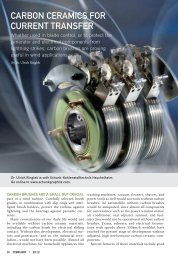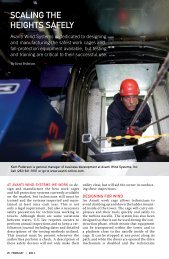download pdf - Wind Systems Magazine
download pdf - Wind Systems Magazine
download pdf - Wind Systems Magazine
Create successful ePaper yourself
Turn your PDF publications into a flip-book with our unique Google optimized e-Paper software.
MAiNTENANCE<br />
iN MY EARliER DAYS OF WORKiNg iN POWER generation<br />
facilities, it was common policy to give the new<br />
guy a bright red hardhat so that everyone else could look<br />
out for him and help him learn the ropes of the facility.<br />
Though such a policy may have inadvertently sanctioned<br />
the amusing initiation of a new recruit, its intention was<br />
to bring focus on an inexperienced member of the team.<br />
It was this visibility and guidance that helped the new<br />
employee avoid injurious situations until he became<br />
fully aware of his new surroundings.<br />
In a literal sense, poor visibility can be the cause of<br />
many hazards and injuries in our industry. <strong>Wind</strong> technicians<br />
work with their hands, whether it is with rigging<br />
equipment, hand tools, or climbing a turbine. Part of the<br />
responsibility of providing maintenance services is to<br />
continuously find ways to improve the safe working conditions<br />
of technicians. Whether we work during dusk<br />
or dawn hours, in high traffic construction areas, or in<br />
dimly lit towers and hubs, the risk of injury due to poor<br />
visibility can increase significantly.<br />
According to the Bureau of Labor Statistics (BLS), the<br />
agency that compiles OSHA reportable injuries, in 2010<br />
more than 209,000 injuries to the arms and hands were<br />
reported in the U.S. private workplace sector. Of those<br />
reported injuries, nearly 55% resulted in more than six<br />
days away from work. While we may logically believe<br />
that many of these types of injuries occurred before<br />
someone was really thinking about their task or when<br />
they became tired at the end of a long day, the fact is that<br />
most were inflicted at least two hours after the start of<br />
work and during work periods of less than ten hours.<br />
This particular BLS statistic might suggest that workers<br />
should be wide-awake, but simply not focused on the<br />
task at hand. Even the day of the week seems irrelevant,<br />
as the number of arm and hand injuries reported in 2010<br />
varied by less than 3% Monday through Friday.<br />
Certainly not a surprise to anyone the most common<br />
causes of these types of injuries are carelessness,<br />
lack of awareness, boredom, distractions, and disregard<br />
for safety procedures. Often the technician places their<br />
non-dominant hand in the line of fire, increasing the<br />
risk of hand injuries. At one time the worker can be a<br />
wide-awake and unwitting participant in an unsafe act,<br />
yet at another they can avoid the very same actions that<br />
put them in harm’s way. Perhaps in the first scenario, the<br />
hand or arm just wasn’t conspicuous enough to immediately<br />
gain the attention of the technician.<br />
Conspicuity refers to the ability of an object to draw<br />
attention to its presence, even when someone is not ac-<br />
18 AUGUST | 2012<br />
Merritt Brown<br />
Rev1 Power Services, inc.<br />
in an effort to reduce hand and arm injuries, we should learn from the research on high<br />
visibility clothing and how we can make our hazards more conspicuous and safer.<br />
tively looking for it. We know for example how a vehicle’s<br />
headlights and brake lights make them conspicuous, or<br />
how a bright red hardhat brings our attention to a new<br />
employee. When we are casually looking around, sometimes<br />
an object will jump out of the background. Since<br />
getting technicians to notice where their hands and<br />
arms are placed can literally be a matter of life and death,<br />
creating an up tower work environment where arms and<br />
hands become more conspicuous, and where hazards<br />
can be found, will provide a real safety advantage.<br />
High visibility clothing has been around since the<br />
1970’s and has become commonplace in today’s wind<br />
construction industry. During construction or major<br />
maintenance high visibility vests are worn as a means<br />
to deliberately make the workers conspicuous to others.<br />
For many years red was considered the most conspicuous<br />
color but recent research has established that the<br />
most conspicuous colors are yellow and yellow-green,<br />
sometimes called lime yellow. Because the color-transmitting<br />
cones in our eyes do not work well in the dark,<br />
some colors are easier for us to see at night. We are most<br />
sensitive to greenish-yellow colors under dim conditions,<br />
making lime shades easiest to see in low lighting.<br />
This led to a study that found yellow-green fire engines<br />
have far fewer accidents than red ones, and now communities<br />
across the country are replacing the traditional<br />
red fire truck.<br />
Considering the outcome of such studies, wearing<br />
clothing that is inconspicuous may be a leading contributor<br />
to many hand and arm injuries in our industry.<br />
Wearing black gloves that are close in color to the<br />
equipment we work on, for example, does little to draw<br />
sensory perception to where the hands are placed.<br />
Brightly colored gloves or those with bright colored<br />
fingertips can increase technician awareness of hand<br />
safety while working. In many safety-critical situations,<br />
it is vital that a viewer notice a sign or other object in<br />
order to avoid injury. However, words and numbers<br />
are not good conspicuity devices because reading text<br />
takes good acuity and mental effort. Color on the other<br />
hand, is easily and quickly perceived without the cognitive<br />
effort required in reading and can be perceived in<br />
peripheral as well as in central vision. Color-labeling<br />
what is otherwise an inconspicuous hazard can bring<br />
attention to pinch points, high voltage connections,<br />
and sharp edges.<br />
Being left to work with some engineered hazards on<br />
our turbines, the least we can do is identify them and<br />
make them as conspicuous as we can.<br />
Merritt brown is vice president of Rev1 Renewables, an energy services company supporting wind, solar, and biomass<br />
clients worldwide. To learn more call (866) 738-1669 or go online to www.rev1renewables.com.




